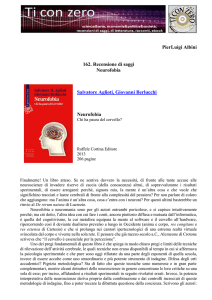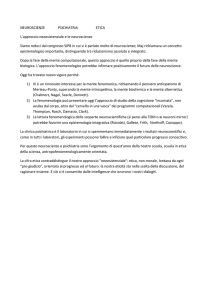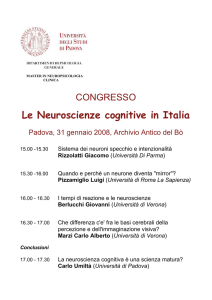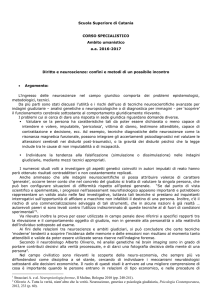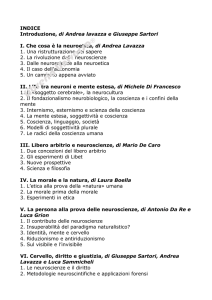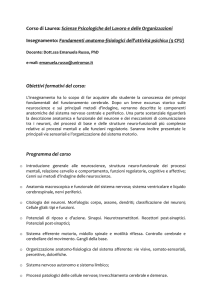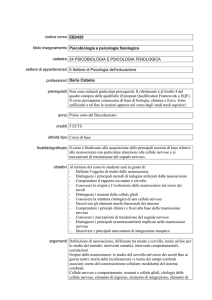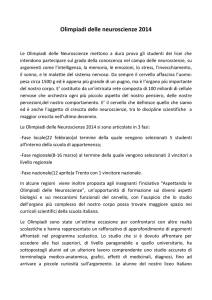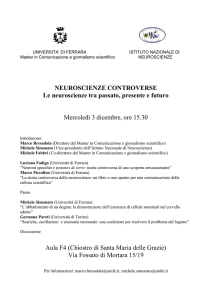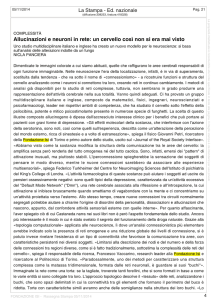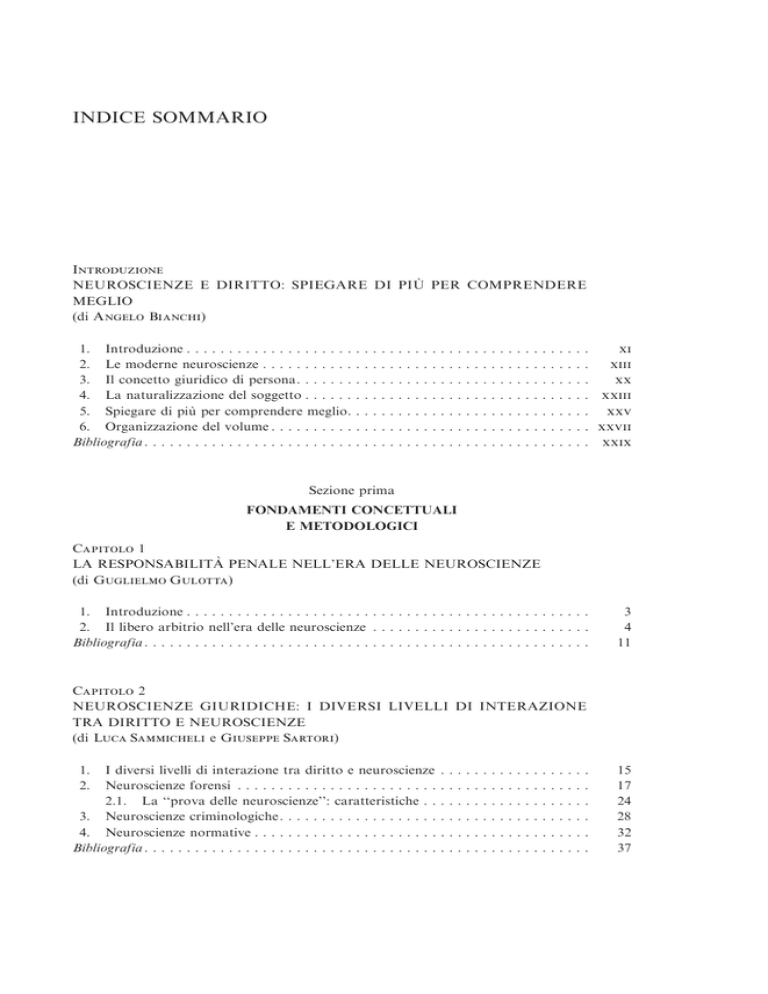
INDICE SOMMARIO
Introduzione
NEUROSCIENZE E DIRITTO: SPIEGARE DI PIÙ PER COMPRENDERE
MEGLIO
(di Angelo Bianchi)
1. Introduzione . . . . . . . . . . . . . . . . . . . .
2. Le moderne neuroscienze . . . . . . . . . . .
3. Il concetto giuridico di persona. . . . . . .
4. La naturalizzazione del soggetto . . . . . .
5. Spiegare di più per comprendere meglio.
6. Organizzazione del volume . . . . . . . . . .
Bibliografia . . . . . . . . . . . . . . . . . . . . . . . . .
.
.
.
.
.
.
.
.
.
.
.
.
.
.
.
.
.
.
.
.
.
.
.
.
.
.
.
.
.
.
.
.
.
.
.
.
.
.
.
.
.
.
.
.
.
.
.
.
.
.
.
.
.
.
.
.
.
.
.
.
.
.
.
.
.
.
.
.
.
.
.
.
.
.
.
.
.
.
.
.
.
.
.
.
.
.
.
.
.
.
.
.
.
.
.
.
.
.
.
.
.
.
.
.
.
.
.
.
.
.
.
.
.
.
.
.
.
.
.
.
.
.
.
.
.
.
.
.
.
.
.
.
.
.
.
.
.
.
.
.
.
.
.
.
.
.
.
.
.
.
.
.
.
.
.
.
.
.
.
.
.
.
.
.
.
.
.
.
.
.
.
.
.
.
.
.
.
.
.
.
.
.
.
.
.
.
.
.
.
.
xi
.
xiii
.
xx
. xxiii
. xxv
. xxvii
. xxix
Sezione prima
FONDAMENTI CONCETTUALI
E METODOLOGICI
Capitolo 1
LA RESPONSABILITÀ PENALE NELL’ERA DELLE NEUROSCIENZE
(di Guglielmo Gulotta)
1. Introduzione . . . . . . . . . . . . . . . . . . . . . . . . . . . . . . . . . . . . . . . . . . . . . . . .
2. Il libero arbitrio nell’era delle neuroscienze . . . . . . . . . . . . . . . . . . . . . . . . . .
Bibliografia . . . . . . . . . . . . . . . . . . . . . . . . . . . . . . . . . . . . . . . . . . . . . . . . . . . . .
3
4
11
Capitolo 2
NEUROSCIENZE GIURIDICHE: I DIVERSI LIVELLI DI INTERAZIONE
TRA DIRITTO E NEUROSCIENZE
(di Luca Sammicheli e Giuseppe Sartori)
1.
2.
I diversi livelli di interazione tra diritto e neuroscienze
Neuroscienze forensi . . . . . . . . . . . . . . . . . . . . . . . .
2.1. La ‘‘prova delle neuroscienze’’: caratteristiche . .
3. Neuroscienze criminologiche. . . . . . . . . . . . . . . . . . .
4. Neuroscienze normative . . . . . . . . . . . . . . . . . . . . . .
Bibliografia . . . . . . . . . . . . . . . . . . . . . . . . . . . . . . . . . . .
.
.
.
.
.
.
.
.
.
.
.
.
.
.
.
.
.
.
.
.
.
.
.
.
.
.
.
.
.
.
.
.
.
.
.
.
.
.
.
.
.
.
.
.
.
.
.
.
.
.
.
.
.
.
.
.
.
.
.
.
.
.
.
.
.
.
.
.
.
.
.
.
.
.
.
.
.
.
.
.
.
.
.
.
.
.
.
.
.
.
.
.
.
.
.
.
.
.
.
.
.
.
.
.
.
.
.
.
15
17
24
28
32
37
vi
indice sommario
Capitolo 3
HOMO FEROX: IL CONTRIBUTO DELLE NEUROSCIENZE ALLA
COMPRENSIONE DEI COMPORTAMENTI AGGRESSIVI E CRIMINALI
(di Pietro Pietrini e Valentina Bambini)
1.
2.
Introduzione . . . . . . . . . . . . . . . . . . . . . . . . . . . . . . . . . . . . . . . . . . . . . . . .
Viaggio nel cervello alla ricerca della mente: le metodologie di esplorazione
metabolica e funzionale del sistema nervoso . . . . . . . . . . . . . . . . . . . . . . . . . .
3. Homo ferox . . . . . . . . . . . . . . . . . . . . . . . . . . . . . . . . . . . . . . . . . . . . . . . .
3.1. Il cervello aggressivo: le basi cerebrali del controllo degli impulsi . . . . . .
3.2. Il cervello criminale: differenze morfologiche e funzionali tra soggetti
sani e criminali . . . . . . . . . . . . . . . . . . . . . . . . . . . . . . . . . . . . . . . . . .
4. Ripensando la responsabilità: dalle neuroscienze all’etica, alla legge . . . . . . . . .
4.1. Libero arbitrio o libero veto? . . . . . . . . . . . . . . . . . . . . . . . . . . . . . . . .
4.2. Mens rea o mens aegra? . . . . . . . . . . . . . . . . . . . . . . . . . . . . . . . . . . .
5. Conclusioni. . . . . . . . . . . . . . . . . . . . . . . . . . . . . . . . . . . . . . . . . . . . . . . . .
Bibliografia . . . . . . . . . . . . . . . . . . . . . . . . . . . . . . . . . . . . . . . . . . . . . . . . . . . . .
41
44
47
49
54
58
58
60
62
64
Capitolo 4
IL RUOLO DEI FATTORI GENETICI NELLA MODULAZIONE DEL
COMPORTAMENTO: LE NUOVE ACQUISIZIONI DELLA BIOLOGIA
MOLECOLARE GENETICA
(di Silvia Pellegrini)
1. Introduzione . . . . . . . . . . . . . . . . . . . . . . . . . . . . . . . . . . . . . . . . . .
2. Strategie per lo studio dei fattori genetici del comportamento . . . . . . .
3. Il genoma umano e le varianti alleliche . . . . . . . . . . . . . . . . . . . . . . .
4. Approcci metodologici per lo studio dei fattori genetici di suscettibilità
5. Geni e comportamento. . . . . . . . . . . . . . . . . . . . . . . . . . . . . . . . . . .
6. Implicazioni etiche delle conoscenze genetiche . . . . . . . . . . . . . . . . . .
Bibliografia . . . . . . . . . . . . . . . . . . . . . . . . . . . . . . . . . . . . . . . . . . . . . . .
.
.
.
.
.
.
.
.
.
.
.
.
.
.
.
.
.
.
.
.
.
.
.
.
.
.
.
.
.
.
.
.
.
.
.
.
.
.
.
.
.
.
69
71
73
75
79
83
88
.
.
.
.
.
.
.
.
.
.
.
.
.
.
.
.
.
.
.
.
.
.
.
.
.
.
.
.
.
.
.
.
.
.
.
.
.
.
.
.
.
.
.
.
.
.
.
.
.
.
.
.
.
.
91
92
96
96
98
100
102
104
106
Capitolo 5
PSICODIAGNOSTICA FORENSE: UTILITÀ E LIMITI
(di Angelo Bianchi)
1.
2.
3.
Introduzione . . . . . . . . . . . . . . . . . . . . . . . . . . . . . . . . . . . . .
La natura dell’evidenza psicodiagnostica forense . . . . . . . . . . .
Una classificazione ragionata dei test psicodiagnostici forensi . .
3.1. I test proiettivi . . . . . . . . . . . . . . . . . . . . . . . . . . . . . . .
3.2. Gli inventari di personalità . . . . . . . . . . . . . . . . . . . . . .
3.3. I test neuropsicologici . . . . . . . . . . . . . . . . . . . . . . . . . .
3.4. Le interviste, le rating scales e le checklists diagnostiche . .
3.5. Le interviste ed i questionari per la credibilità dei sintomi
Bibliografia . . . . . . . . . . . . . . . . . . . . . . . . . . . . . . . . . . . . . . . . . .
.
.
.
.
.
.
.
.
.
.
.
.
.
.
.
.
.
.
.
.
.
.
.
.
.
.
.
.
.
.
.
.
.
.
.
.
.
.
.
.
.
.
.
.
.
indice sommario
vii
Sezione seconda
NEUROSCIENZE E PROCESSO PENALE
Capitolo 6
LA NEUROPSICOLOGIA CRIMINALE E DELL’IMPUTABILITÀ MINORILE
(di Guglielmo Gulotta e Georgia Zara)
1.
2.
3.
4.
5.
6.
7.
8.
Introduzione . . . . . . . . . . . . . . . . . . . . . . . . . . . . . . . . . . . . . . . . . . . . . . . .
Mondo della giustizia e mondo scientifico . . . . . . . . . . . . . . . . . . . . . . . . . . .
L’emergere del paradigma neuropsicologico forense . . . . . . . . . . . . . . . . . . . .
Responsabilità e imputabilità minorile . . . . . . . . . . . . . . . . . . . . . . . . . . . . . .
Il dilemma della scelta dell’età della responsabilità . . . . . . . . . . . . . . . . . . . . .
Adolescenza prolungata o adultità emergente? . . . . . . . . . . . . . . . . . . . . . . . .
Lo sviluppo neuropsicologico . . . . . . . . . . . . . . . . . . . . . . . . . . . . . . . . . . . .
Cambiamenti lineari nella sostanza bianca e non-lineari nella sostanza grigia:
impatto sul comportamento . . . . . . . . . . . . . . . . . . . . . . . . . . . . . . . . . . . . .
9. Gerarchia neuropsicologica: le funzioni esecutive e il comportamento complesso .
10. Dinamica nature vs nurture e comportamento. . . . . . . . . . . . . . . . . . . . . . . . .
11. Natura tumultuosa dell’adolescenza . . . . . . . . . . . . . . . . . . . . . . . . . . . . . . .
12. La responsabilità criminale minorile: una meta-valutazione . . . . . . . . . . . . . . .
13. Riflessioni conclusive . . . . . . . . . . . . . . . . . . . . . . . . . . . . . . . . . . . . . . . . . .
Bibliografia . . . . . . . . . . . . . . . . . . . . . . . . . . . . . . . . . . . . . . . . . . . . . . . . . . . . .
109
112
115
118
121
123
125
127
133
137
140
143
147
149
Capitolo 7
MENZOGNA, CERVELLO E LIE DETECTION
(di Giuseppe Sartori e Sara Agosta)
1.
2.
Introduzione . . . . . . . . . . . . . . . . . . . . . . . . . . . . . . . . . . . . . . . . . . .
Metodologie finalizzate ad identificare la menzogna (lie detection) . . . . .
2.1. Il poligrafo con Control Question Test . . . . . . . . . . . . . . . . . . . .
2.2. La fMRI (Risonanza Magnetica Funzionale). . . . . . . . . . . . . . . .
2.3. Infrarossi . . . . . . . . . . . . . . . . . . . . . . . . . . . . . . . . . . . . . . . . .
2.4. Critiche alle tecniche tradizionali di ‘‘lie detection’’ . . . . . . . . . . .
3. Metodologie finalizzate ad identificare una traccia di memoria (memory
tion) . . . . . . . . . . . . . . . . . . . . . . . . . . . . . . . . . . . . . . . . . . . . . . . . .
3.1. Poligrafo con Guilty Knowledge Test . . . . . . . . . . . . . . . . . . . . . .
3.2. Autobiographical - Implicit Association Test (aIAT) . . . . . . . . . .
4. Conclusioni. . . . . . . . . . . . . . . . . . . . . . . . . . . . . . . . . . . . . . . . . . . .
Bibliografia . . . . . . . . . . . . . . . . . . . . . . . . . . . . . . . . . . . . . . . . . . . . . . . .
.....
.....
.....
.....
.....
.....
detec.....
.....
.....
.....
.....
163
169
169
170
171
171
Introduzione . . . . . . . . . . . . . . . . . . . . . . . . . . . . . . . . . . . . . . . . . . . . . . . .
Applicazioni e riflessi delle neuroscienze nel diritto penale. . . . . . . . . . . . . . . .
193
195
172
173
174
188
191
Capitolo 8
LE NEUROSCIENZE ED IL PARADIGMA DELLA NUOVA PROVA
SCIENTIFICA
(di Cataldo Intrieri)
1.
2.
viii
indice sommario
3.
4.
5.
6.
7.
8.
La visione e la misura del ricordo . . . . . . . . . . . . . . . . . . . . . . . . . . . . . . . . .
‘‘Vedere’’ la menzogna . . . . . . . . . . . . . . . . . . . . . . . . . . . . . . . . . . . . . . . . .
La prova scientifica del sistema processuale statunitense . . . . . . . . . . . . . . . . .
Il cervello come physical evidence . . . . . . . . . . . . . . . . . . . . . . . . . . . . . . . . .
La prova scientifica ed il catalogo legale in Italia . . . . . . . . . . . . . . . . . . . . . .
Una diversa prospettiva: il metodo scientifico e la categoria dell’idoneità probatoria . . . . . . . . . . . . . . . . . . . . . . . . . . . . . . . . . . . . . . . . . . . . . . . . . . . .
9. La prova atipica dei tribunali italiani: precedenti e prospettive . . . . . . . . . . . .
10. Le neuroscienze e la testimonianza. Possibili sviluppi . . . . . . . . . . . . . . . . . . .
11. Nuove tecniche. Il futuro (forse) è già iniziato . . . . . . . . . . . . . . . . . . . . . . . .
12. Free Will: un falso problema . . . . . . . . . . . . . . . . . . . . . . . . . . . . . . . . . . . .
13. Conclusioni. . . . . . . . . . . . . . . . . . . . . . . . . . . . . . . . . . . . . . . . . . . . . . . . .
Bibliografia . . . . . . . . . . . . . . . . . . . . . . . . . . . . . . . . . . . . . . . . . . . . . . . . . . . . .
198
200
202
207
209
212
214
217
218
224
226
229
Capitolo 9
LIBERTÀ MORALE E RICERCA PROCESSUALE DELLA VERITÀ:
METODICHE NEUROSCIENTIFICHE
(di Luca Sammicheli, Antonio Forza e Luisella de Cataldo Neuburger)
1.
2.
3.
4.
5.
Premesse . . . . . . . . . . . . . . . . . . . . . . . . . . . . . . . . . . . . . . . . .
L’estorsione della verità . . . . . . . . . . . . . . . . . . . . . . . . . . . . . .
Le diverse ‘‘macchine della verità’’: un confronto tecnico ed etico
Una prima riflessione comparativa . . . . . . . . . . . . . . . . . . . . . .
Quali spazi di applicabilità forense?. . . . . . . . . . . . . . . . . . . . . .
5.1. Contenuto definitorio delle norme . . . . . . . . . . . . . . . . . .
5.2. Contenuto probatorio prodotto dalla ‘‘macchina’’ . . . . . . .
5.3. Margini di applicazione in ambito processuale. . . . . . . . . .
6. Conclusioni. . . . . . . . . . . . . . . . . . . . . . . . . . . . . . . . . . . . . . .
Bibliografia . . . . . . . . . . . . . . . . . . . . . . . . . . . . . . . . . . . . . . . . . . .
.
.
.
.
.
.
.
.
.
.
.
.
.
.
.
.
.
.
.
.
.
.
.
.
.
.
.
.
.
.
.
.
.
.
.
.
.
.
.
.
.
.
.
.
.
.
.
.
.
.
.
.
.
.
.
.
.
.
.
.
.
.
.
.
.
.
.
.
.
.
.
.
.
.
.
.
.
.
.
.
.
.
.
.
.
.
.
.
.
.
.
.
.
.
.
.
.
.
.
.
231
233
237
247
248
248
251
253
255
256
.
.
.
.
.
.
.
.
.
.
.
.
.
.
.
.
.
.
.
.
.
.
.
.
.
.
.
.
.
.
.
.
.
.
.
.
.
.
.
.
.
.
.
.
.
.
.
.
.
.
.
.
.
.
.
.
.
.
.
.
.
.
.
.
.
.
.
.
.
.
.
.
.
.
.
.
.
.
.
.
261
262
268
273
277
279
280
281
Parte terza
NEUROSCIENZE E PROCESSO CIVILE
Capitolo 10
NEUROSCIENZE E DANNO ALLA PERSONA
(di Angelo Bianchi e Sara Pezzuolo)
1.
2.
3.
Introduzione . . . . . . . . . . . . . . . . . . . . . . . . . . . . . . . . . . . .
Abbandonare il dualismo mente-corpo . . . . . . . . . . . . . . . . .
2.1. Le risposte biologiche al trauma e allo stress . . . . . . . . .
2.2. Le componenti psicologiche della risposta allo stress . . .
2.3. Fattori sociali e contestuali nella risposta allo stress. . . .
I traumi emozionali . . . . . . . . . . . . . . . . . . . . . . . . . . . . . . .
3.1. Il disturbo psicotico breve ed il disturbo acuto da stress .
3.2. Il disturbo post-traumatico da stress. . . . . . . . . . . . . . .
.
.
.
.
.
.
.
.
.
.
.
.
.
.
.
.
indice sommario
3.3. I disturbi dell’adattamento. . . . . . .
3.4. Il lutto . . . . . . . . . . . . . . . . . . . . .
4. I traumi cerebrali. . . . . . . . . . . . . . . . . .
4.1. I traumi cerebrali gravi . . . . . . . . .
4.2. I traumi cerebrali di media gravità .
4.3. I traumi cerebrali lievi . . . . . . . . . .
4.4. Il colpo di frusta. . . . . . . . . . . . . .
4.5. Le intossicazioni cerebrali . . . . . . .
Bibliografia . . . . . . . . . . . . . . . . . . . . . . . . . .
.
.
.
.
.
.
.
.
.
.
.
.
.
.
.
.
.
.
.
.
.
.
.
.
.
.
.
.
.
.
.
.
.
.
.
.
.
.
.
.
.
.
.
.
.
ix
.
.
.
.
.
.
.
.
.
.
.
.
.
.
.
.
.
.
.
.
.
.
.
.
.
.
.
.
.
.
.
.
.
.
.
.
.
.
.
.
.
.
.
.
.
.
.
.
.
.
.
.
.
.
.
.
.
.
.
.
.
.
.
.
.
.
.
.
.
.
.
.
.
.
.
.
.
.
.
.
.
.
.
.
.
.
.
.
.
.
.
.
.
.
.
.
.
.
.
.
.
.
.
.
.
.
.
.
.
.
.
.
.
.
.
.
.
.
.
.
.
.
.
.
.
.
.
.
.
.
.
.
.
.
.
.
.
.
.
.
.
.
.
.
.
.
.
.
.
.
.
.
.
.
.
.
.
.
.
.
.
.
.
.
.
.
.
.
.
.
.
.
.
.
.
.
.
.
.
.
.
.
.
.
.
.
.
.
.
.
.
.
.
.
.
.
.
.
290
293
299
301
303
304
310
316
319
.
.
.
.
.
.
.
.
.
.
.
.
.
.
.
.
.
.
.
.
.
.
.
.
.
.
.
.
.
.
327
330
333
336
340
345
Capitolo 11
RISOLUZIONI DEFINITIVE E STATI D’ANIMO NON DURATURI:
LA VALUTAZIONE DELLA CAPACITÀ DI AUTODETERMINAZIONE
IN AMBITO SANITARIO
(di Bruno Magliona)
1. Dalla capacità di intendere e volere alla clinical competence. . . . . . . . . .
2. Quando si pone la necessità di una valutazione della clinical competence
3. Verso una valutazione strutturata della clinical competence . . . . . . . . . .
4. Il ruolo dell’indagine neuropsicologica. . . . . . . . . . . . . . . . . . . . . . . . .
5. Metodologia della valutazione della clinical competence. . . . . . . . . . . . .
Bibliografia . . . . . . . . . . . . . . . . . . . . . . . . . . . . . . . . . . . . . . . . . . . . . . . .
Capitolo 12
CAPACITÀ E COMPETENZE RESIDUE NELLE GRAVI CEREBROLESIONI
ACQUISITE
(di Marina Zettin e Michela Zorniotti)
1. Il concetto di capacità e competenze . . . . . . . . . . . . . . . . . . . . . .
2. Le gravi cerebrolesioni acquisite e le conseguenti sindromi frontali.
3. Una nuova possibilità: la riabilitazione neuropsicologica . . . . . . . .
4. Un cervello tra altri cervelli: la teoria della mente. . . . . . . . . . . . .
5. La teoria dei marker somatici . . . . . . . . . . . . . . . . . . . . . . . . . . .
6. Una visione d’insieme . . . . . . . . . . . . . . . . . . . . . . . . . . . . . . . .
Bibliografia . . . . . . . . . . . . . . . . . . . . . . . . . . . . . . . . . . . . . . . . . . . .
.
.
.
.
.
.
.
.
.
.
.
.
.
.
.
.
.
.
.
.
.
.
.
.
.
.
.
.
.
.
.
.
.
.
.
.
.
.
.
.
.
.
.
.
.
.
.
.
.
.
.
.
.
.
.
.
.
.
.
.
.
.
.
351
358
366
371
373
374
378
Premessa sulla capacità . . . . . . . . . . . . . . . . . . . . . . . . . . . . . . . . . . . . . . . .
La capacità nei pazienti con demenza . . . . . . . . . . . . . . . . . . . . . . . . . . . . . .
383
386
Capitolo 13
LA VALUTAZIONE DELLA CAPACITÀ DI AGIRE NEI PAZIENTI
CON DEMENZA
(di Carlo Alberto Defanti, Azelio Martina e Leonardo Sacco)
1.
2.
x
3.
4.
indice sommario
La ricerca sulla capacità dei pazienti con demenza . . . . . . . . . . .
Un nostro tentativo di ricerca sulla capacità . . . . . . . . . . . . . . .
4.1. Un’altra esperienza: la valutazione della capacità di votare .
5. Conclusioni. . . . . . . . . . . . . . . . . . . . . . . . . . . . . . . . . . . . . . .
Bibliografia . . . . . . . . . . . . . . . . . . . . . . . . . . . . . . . . . . . . . . . . . . .
.
.
.
.
.
.
.
.
.
.
.
.
.
.
.
.
.
.
.
.
.
.
.
.
.
.
.
.
.
.
.
.
.
.
.
.
.
.
.
.
.
.
.
.
.
.
.
.
.
.
387
389
397
400
402
Indice analitico . . . . . . . . . . . . . . . . . . . . . . . . . . . . . . . . . . . . . . . . . . . . . . . . . .
405

